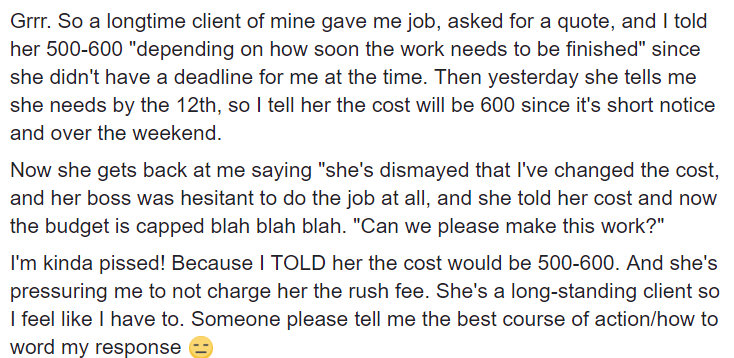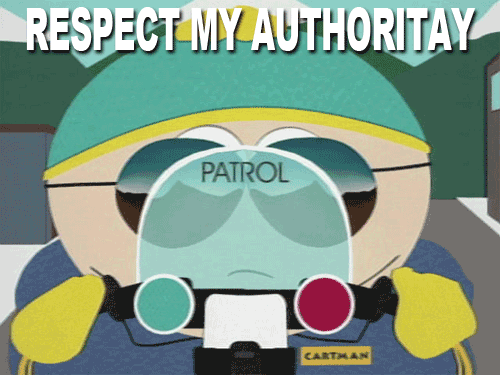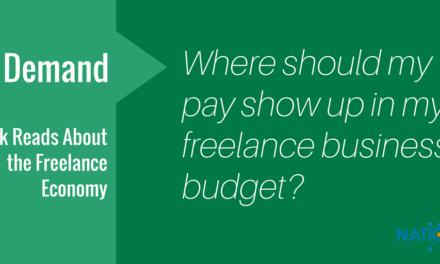Experienced freelancers will eventually have a client contact them to say they need something done urgently — like in 24 hours or less or by Monday morning or before they board their plane Sunday night for a Monday meeting. Oftentimes, responding to this rush job is doable but inconvenient because it means postponing your marketing activities or other work important to your freelance business. In some cases it would infringe on your personal time. The solution in these cases is to charge a rush fee.
This client is asking for a rush job. A rush job is any client work that restrains your capacity or alters your management plan by pulling resources away. Rush jobs are when:
- you have to tell your assistant or your subcontractors to stop what they’re doing and to turn their attention to this urgent job.
- you have to spend your valuable time on activities that normally gets paid less.
- you have to stop working on your business plan.
- you have to stop getting more prospective clients into your pipeline.
- you have to stop working smarter and just get through the work by brute force.
- you have to work nights or weekends.
Rush jobs deserve to be compensated in some way by a rush fee. A rush fee is a surcharge to the client over your normal rates to account for you shifting resources around.
Are you looking for ideas on how to grow your freelance career? We put together the best ideas from across Nation1099 into an ebook — 15 Easy Hacks For Finding More Freelance Clients. Even better, this ebook includes two fantastic giveaways to valuable services.
But right off, you may have a common concern here’s one concern about charging extra for rush jobs that might be weighing on you:
“If I charge a rush fee, won’t that damage the relationship with my client?”
That depends on the expectations you established in the past. If you have a clear statement of work that identifies timelines and responsibilities on each side, then it will be clear where this rush job fits in.
With a strong foundation in place, your client will understand that what they are asking for is a kind of change order. Reasonable clients expect to pay a rush fee in those cases.
Without a clear statement of work (also called a scope of work), then you are vulnerable to scope creep.
Think of the rush fee as a kind of service to your clients rather than something that will offend them. Sudden changes that need a quick response are an unavoidable reality in the fast-paced businesses your clients are working in. It’s understandable that clients need a rush job sometimes, and it’s understandable that they can’t predict when that will be.
A rush fee enables you to provide a valuable service to clients in those circumstances. In fact, it’s worthwhile to anticipate this issue and to put language about rush fees (and other forms of change orders and overages) into your scope of work so that clients know they can ask for it. You can cover this in the Extra Charges section of your contract. Here is an example of rush fee wording:
“Client may request additional deliverables beyond this scope at an hourly rate of $_____. Normal turnaround time for first drafts on assigned deliverables is one week. Clients may request rush jobs on new or existing assignments for an additional charge of 25 percent of the hourly rate.”
The trick is to make a rush fee sound like a service that is available to your clients — not a penalty you are imposing.
The standard rush fee approach sends the wrong message
Approaching a rush fee as a service is a change in mindset. Many freelancers say rush fees should act as a deterrent . . . that the whole point is to put your clients off.
This is completely counterproductive. You want to work more with your clients, not less. You want to be a problem solver.



I don’t want to call anybody out, but here is some of the language I found out there about charging rush fees that I think is counterproductive:
- remove the aggravation
- wreak havoc
- anxiety-filled hours of torture
- thinks I can drop whatever I’m doing
- negotiating power
- over a barrel
- demand more money
And then there’s this old saw: “You can have it 1.) Cheap, 2.) Fast or 3.) Good. Choose any two.”
Don’t be that jackass.
I understand that many freelancers feel disrespected as professionals by clients. Acting like a pill about rush jobs may feel like grabbing your chance to demand professional respect.
But this is what clients hear . . .

There are ways to professionalize as freelancers without treating clients as adversaries. It’s far better to understand where they’re coming from and to explain respectfully how we can help them.
If you can’t help them, just say you’re not available and move on without the drama.
When you charge a rush fee, you are adding a premium for premium service. Think of this as an opportunity to sell additional services. You may even discover a new area of client needs and an opportunity to expand your business in new directions. Focus less on the aggravation and more on how you can solve a problem for your client.
How much should I charge for a rush fee?
To calculate a rush fee, start with your hourly rate and then consider these three categories of rush jobs:
- If the work can be done in a normal way during normal working hours but pulls you away from other activities that will have to be rescheduled, keep the rush fee lower. Essentially the client is paying for the “switching costs” of moving your attention around. Add 25 percent to your hourly rate in this case.
- If the work can be done during normal business hours but not in the normal way because it disrupts your process, that is less convenient. For example, if the normal process is to use a subcontractor for part of the work, but on short notice you will have to do it yourself, that requires a higher fee. Add 50 percent to your hourly rate in cases like that.
- If the work can’t be done during normal business hours and you will have to work nights and weekends or otherwise cut into your personal time, treat yourself like an hourly employee would be treated for overtime in those situations. Add 100 percent to your hourly rate in that case.
When should you waive a rush fee?
Sometimes it makes sense not to charge a rush fee. The rush job might be such a small piece that it’s not worth the back and forth. Or it might be small relative to how big the client is for your business or how consistent they are.
But the fee has to exist in principle before you can waive it. So make sure to have clear policies in advance.
When you do waive the rush fee, include an item for it on the invoice at the end of the month, and show that you are charging zero. That way your client is aware that you provided extra service and that they shouldn’t take it for granted.
The other case where you don’t charge a rush fee is when this is happening on a consistent basis with a client. Here, you have actually discovered that the client needs someone who is on call. This is an opportunity to sell a higher-priced retainer contract. The client pays in advance every month for the ability to command your attention when they need it for a certain number of hours each month.
This is essentially how a “personal attorney” works. When The call comes from the client saying they need a contract reviewed this afternoon, the lawyer gets on the job immediately. If the client doesn’t use all the hours, those are rolled over to the next month up to a cap, and the lawyer is paid in full for all the unused hours at the end of the year.
Should you get paid in advance for a rush job?
In theory this makes sense. If they need a rush job, then you need a rush payment. The ideal would be to get a deposit of 50 percent in advance. You simply tell them, “I’m looking forward to jumping on this as soon as I receive the deposit.”
In practice, this is often harder to implement. Most experienced freelancers know that under the best of circumstances their clients can take weeks to get approvals and route invoices. You may need to go on faith, and it may make sense to do rush jobs only for established clients.
Here are two solutions to this problem of speedy payment:
First, if this discussion is happening on the phone, get them to commit verbally to prompt payment — that they will route the invoice immediately. Then follow up with an email confirming all the details you discussed. Then send the invoice.
Second, it’s probably time to switch to some form of online invoicing system anyway, which often allow clients to pay be credit card to Paypal. If your client has purchasing authority on a credit card, you can get your deposit within a few minutes. If you’ve been avoiding these services because of the extra costs, pass the costs on to your clients.
Many of these have a free one-month trial. If you are reading this because you have a client with a rush job right now, here’s where to jump in:
- Freshbooks works great for getting payment and is especially designed for freelancers.
- Bonsai is a new all-purpose accounting tool for freelancers that lets you collect client payments quickly.
Other reading about freelance rates, fees and payments:
Set Freelance Rates By Starting With This Expense Formula
7 Powerful Strategies for Getting Recurring Income as a Freelancer
2 Signs Your Freelance Fees Are Too Low
Getting the Freelance Rate You Deserve
The Beginner’s Guide To Getting Upfront Payment From Freelance Clients
The Path To Higher Paying Clients – Insights From the Marketing Mentor

Robert McGuire
Publisher of Nation1099
Robert McGuire is the owner of McGuire Editorial, a content marketing services firm specializing in B2B and tech startups.










